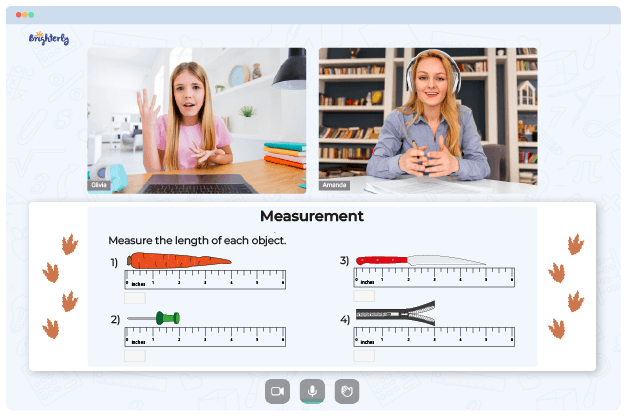Measuring Tape – Definition with Examples
Updated on January 14, 2024
Welcome to Brighterly, the exciting world of math made fun for children! In today’s math lesson, we will dive into the fascinating world of measuring tape. Whether you’re measuring the length of a room, the height of a tree, or even the circumference of the Earth (impressive, right?), measuring tape is an essential tool that helps us quantify and understand the world around us.
What is a Measuring Tape?
A measuring tape is a flexible strip of material, typically made of metal or fiberglass, with markings indicating units of length. It is used to measure distances and lengths with precision. Measuring tapes come in various lengths, ranging from a few feet to several meters, and they are commonly used in fields such as construction, tailoring, and carpentry.
How Does a Measuring Tape Work?
To use a measuring tape, simply extend the tape along the object you wish to measure. The markings on the tape indicate the length in a specific unit, such as inches, centimeters, or feet. The tape is typically retractable, allowing you to easily wind it back into its case after use.
Measuring Tape Examples
Let’s explore a few examples to understand how measuring tape is used in real-life situations:
-
Measuring a Room: Imagine you’re rearranging your bedroom furniture, and you want to ensure everything fits perfectly. You can use a measuring tape to measure the dimensions of the room accurately. Measure the length, width, and height of the room to determine the available space for your furniture.
-
Tailoring: If you’re interested in fashion and sewing, a measuring tape is your best friend. Tailors use measuring tapes to take precise measurements of a person’s body, ensuring the perfect fit for clothes they create. Bust, waist, hip measurements, and more are all taken using this invaluable tool.
-
DIY Projects: Are you a budding carpenter or DIY enthusiast? Measuring tape is a must-have in your toolkit. From cutting boards to building shelves, accurate measurements are essential for successful projects. A measuring tape allows you to measure and mark materials precisely before cutting or assembling them.
Advantages of Measuring Tape
-
Flexibility: Measuring tapes are flexible, making it easier to measure curved or irregularly shaped objects accurately.
-
Portability: Measuring tapes are compact and lightweight, making them convenient to carry around wherever you go.
-
Accuracy: With clear markings and precise measurements, measuring tapes provide accurate results, ensuring you get the right measurements every time.
Choosing the Right Measuring Tape
When it comes to selecting a measuring tape, it’s essential to consider your specific needs. Here are a few factors to keep in mind:
-
Length: Determine the maximum length you’ll need to measure. Measuring tapes come in various lengths, so choose one that can accommodate your intended applications.
-
Units of Measurement: Consider the unit of measurement that is most convenient for your purpose. Whether you prefer inches, centimeters, or feet, ensure that the measuring tape you choose has the markings you require.
-
Durability: Look for a measuring tape made from sturdy materials, such as steel or fiberglass, to ensure longevity and accuracy. A durable measuring tape will withstand frequent use and provide reliable measurements over time.
-
Additional Features: Some measuring tapes come with additional features, such as built-in levels, magnetic tips, or automatic locking mechanisms. Assess these features based on your specific needs and the tasks you’ll be undertaking.
Remember, investing in a quality measuring tape will save you time and effort in the long run, and it’s an essential tool for accurate measurements in various fields.
Measuring Tape Safety Tips
While measuring tapes are relatively simple tools to use, it’s crucial to prioritize safety. Here are some safety tips to keep in mind:
-
Handle with Care: Avoid excessive bending or twisting of the measuring tape, as it can lead to inaccuracies or damage. Treat the tape with care to maintain its precision.
-
Mind the Tape Lock: When extending the measuring tape, ensure the tape lock is engaged to prevent accidental retractions. This will help you maintain control and avoid injuries.
-
Avoid Sharp Edges: Be cautious when using a measuring tape near sharp or pointed objects. The tape can get damaged or cause injury if it comes into contact with sharp edges.
-
Store Properly: After use, retract the tape carefully and store it in a clean and dry location. Protect it from extreme temperatures and keep it away from moisture to preserve its accuracy.
By following these safety tips, you can ensure a safe and enjoyable measuring experience while achieving accurate measurements for your projects.
Enhancing Math Skills with Measuring Tape
Integrating measuring tape into math activities can help children develop their numerical understanding and spatial awareness. Here are a few engaging ways to incorporate measuring tape into math lessons:
-
Measuring Objects: Encourage children to measure various objects around them, such as toys, books, or furniture. They can practice using the measuring tape to determine lengths and compare sizes.
-
Estimation Games: Engage children in estimation games where they predict the length or height of an object before measuring it with a tape. This activity promotes critical thinking and estimation skills.
-
Mathematical Art: Guide children to create mathematical art using measuring tape. They can measure and cut strips of paper or ribbon to create patterns or geometric shapes, fostering creativity and spatial reasoning.
-
Real-Life Problem Solving: Pose real-life measurement problems to children, such as measuring the length of a garden fence or the area of a room. By using measuring tape, they can apply their math skills to practical scenarios.
These interactive activities not only make math enjoyable but also strengthen children’s measurement skills and mathematical thinking.
So, grab a measuring tape and embark on a math adventure with Brighterly, where learning and measuring come alive with excitement and discovery!
Conclusion
Measuring tape is an indispensable tool for accurate measurements in various fields, including construction, tailoring, and DIY projects. It allows us to quantify and understand the world around us with precision. Whether you’re measuring the dimensions of a room, taking body measurements for clothing, or embarking on a creative math activity, a measuring tape is a reliable companion.
At Brighterly, we believe in making math exciting and engaging for children. Introducing measuring tape into math lessons not only enhances their numerical skills but also fosters spatial awareness and critical thinking. By incorporating measuring tape into interactive activities, children can develop a deeper understanding of measurement concepts while having fun.
Frequently Asked Questions
Here are some commonly asked questions about measuring tape:
How do I read measurements on a measuring tape?
Measuring tapes are marked with units of measurement, such as inches, centimeters, or feet. Simply align the starting point of the object you’re measuring with the zero mark on the tape, and read the measurement at the end point of the object.
Can I use a measuring tape to measure curved objects?
Yes, measuring tapes are flexible, allowing you to measure curved or irregularly shaped objects. Wrap the tape around the curve, following the shape closely, and take the measurement accordingly.
How can I ensure accurate measurements with a measuring tape?
To ensure accuracy, make sure the tape is straight and taut when measuring. Avoid bending or kinking the tape, as it may lead to incorrect measurements.
Can children use a measuring tape safely?
Yes, children can use a measuring tape under adult supervision. Teach them how to handle the tape with care, avoid sharp edges, and always retract the tape properly after use.
Are there digital or laser measuring devices available?
Yes, there are digital measuring devices and laser measuring tools available that provide precise measurements. However, they may be more suitable for specific applications and may require additional expertise to operate.




